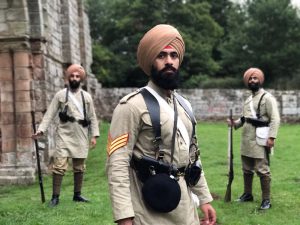Kiran Sahota is a longstanding community partner of the Centre for Hidden Histories. In this guest post, she reflects on how her work on the First World War has inspired her to examine another aspect of history.

I recently attended a special screening of Saragarhi: The True Story, in London on the 120th anniversary of the titular battle. The film was made by Captain Jay Singh Sohal who wanted to tell the story of what happened during the battle.
I was not sure what to expect other than being excited to learn about a history I was not familiar with. While my experience of researching Indian military history was limited, my love for learning about this subject was increasing and I wanted to know more about the twenty-one Sikh men who fought with such courage.
Watching the film, I was drawn to the brave sacrifices these men made and how important it is that we learn their story. Furthermore, it was a fascinating insight into a history I did not know existed. My previous research was about Indian soldiers in the First World War and I had assumed that that was the first time that Indian soldiers fought. The film taught me that Indian soldiers took part in battles of which few people are aware.
The battle took place on 12th September 1897. Twenty-one soldiers of the 36th Sikhs (now the 4th battalion of the Sikh Regiment) were attacked by 10,000 Afghan tribesmen in the North-West Frontier Province, which is now named Khyber-Pakhtunkhwa and part of Pakistan. The British had built a series of forts. Two of the forts, Fort Lockhart and Fort Gulistan, were not visible to each other meaning that remote communication was not possible. Saragarhi was therefore created in between as a heliographic communication post. The Afghans were determined to seize control through sheer weight of number.
Sepoy Gurmukh Singh sent signal to the Colonel John Haughton, Commandant of the 36th Sikhs, that they were under attack but Haughton replied that it was impossible for him to send help. The detachment leader, Havildar Ishar Singh, rather than surrender, led his soldiers to fight to the death. The ensuing battle lasted ten hours. As Sepoy Grumukh was dying it is believed that he yelled out a Sikh battle cry “Bole So Nihal, Sat Sri Akal” which translates to “One will be blessed, who says that God is the ultimate truth”. Each of the 21 Sikhs who sacrificed their lives were awarded the Indian Order of Merit, which was the highest gallantry award which an Indian soldier could receive at the time. The fort was retaken on 14th September, by intensive artillery.

The Battle of Saragarhi might be an untold story to some, but this battle is definitely not forgotten. The film depicts visits to memorial Saragarhi Gurudwaras in India that were dedicated to the men who died. There is one in Amritsar, located near the Golden Temple, at which the names of the twenty one are engraved onto the walls, highlighting their bravery. This Gurudwara is relatively unknown and many people pass it without knowing its significance. There is also a Saragarhi Gurudwara in Ferozepur. This Gurudwara, which was opened in 1904, is surrounded by cannons and is also engraved with the names of the soldiers. The battle is also commemorated by the armed forces in the UK every year on its anniversary.
Learning this history has been informative, especially for someone from a Sikh background. As a British Indian Sikh woman, I have found a new understanding how these men took pride in the religion and culture and have been given much to think about on the determination that these Sikh men had to protect the land and with such pride and courage.
At the end of the screening Jay took time for question and answers session that allowed to speak in depth about the reason this was an important history to highlight. I really enjoyed the screening and having the opportunity to learn more about the history left in India regarding these soldiers.
The film is now available to buy, as is Jay Singh Sohal’s book, Saragarhi: The Forgotten Battle. Screenings of the film are currently taking place. If you are interested in having a screening get in touch with Jay at dothyphen1@gmail.com and you can follow him on Twitter @sikhsatwar